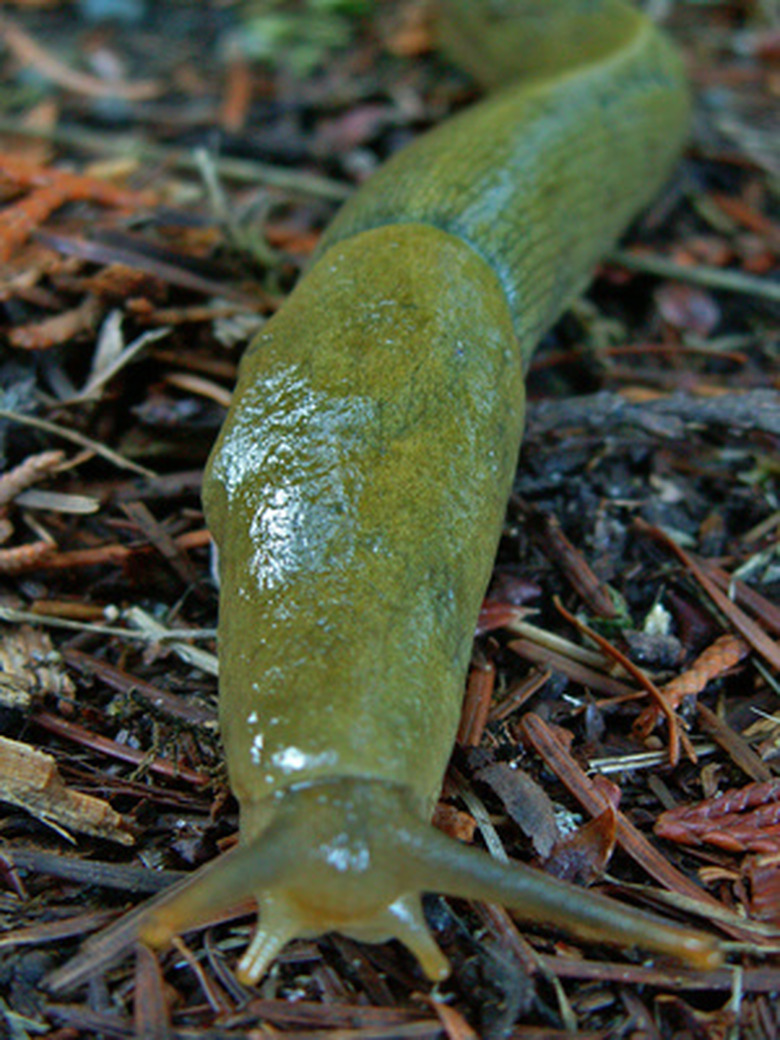Diet Of A Slug
A slug is a gastropod, a land mollusk like the snail but lacking the snail's hard external shell. The slug's diet varies greatly depending upon the type of slug. While most slugs eat plants or fungi, some are actually predators.
What Slugs Eat
Slugs typically eat tender fungi and leafy plants. Favorites include cucumber and oxalis. Slugs also feed off flowering plants and even trees. Many times, slugs will live at the root of the plant, feeding on the roots and bulbs.
- A slug is a gastropod, a land mollusk like the snail but lacking the snail's hard external shell.
- Many times, slugs will live at the root of the plant, feeding on the roots and bulbs.
Leopard Slugs
Unlike most slugs, the leopard slug, named for the dark spots on its light brown body, feeds off dead animal tissue, although it will also eat cat food and pet feces. This slug can be found throughout Australia, primarily in urban areas.
Banana Slugs
Banana slugs are one of the most common types of slugs. Their diet typically includes herbs, lichens, mushrooms and fruit, but, as with most slugs, they will also eat anything from animal waste to each other.
How Slugs Eat
The mouth is on the bottom of a slug and it ingests by crawling over the food. Slugs have a tongue-like organ, a radula, that they use to eat. This tongue is covered in thousands of protrusions called denticles. To find food, they taste and poke with retractable tentacles.
- Unlike most slugs, the leopard slug, named for the dark spots on its light brown body, feeds off dead animal tissue, although it will also eat cat food and pet feces.
- Their diet typically includes herbs, lichens, mushrooms and fruit, but, as with most slugs, they will also eat anything from animal waste to each other.
Self Preservation
If a slug is disturbed or injured in any way, it secretes a sticky slime as a method of protecting itself from predators, predators that could potentially include other slugs. The slime also acts as a natural anesthetic. Native Americans have used the anesthetic properties of slugs for treating toothaches.
Organic Slug & Snail Killer
Any time slugs and snails are a problem, you should look around the garden for places they can hide before installing traps, barriers or baits. Some gardeners apply a black plastic mulch where slugs and snails are severe to heat the soil until it is uninhabitable. Check carefully under leaves and around the base of plants with a flashlight. A variety of barriers provide effective protection against slugs and are often used in conjunction with more deadly control methods. Copper barriers are by far the most effective, though also the most expensive. Direct contact with copper is thought to cause an unpleasant electrical disturbance in slugs and snails. These traps are labor intensive, however, as dead slugs and snail must be removed quickly and the bait replaced about twice a week. Slugs and snails stop feeding after ingesting iron phosphate but it may take several days for them to actually die.
- If a slug is disturbed or injured in any way, it secretes a sticky slime as a method of protecting itself from predators, predators that could potentially include other slugs.
References
- Australia Museum: Leopard Slug
- Garden Organic: Factsheet About Slugs and Snails
- Tserisa Supalla: All About Slugs
- University of California Statewide Integrated Pest Management Program: Brown Garden Snail
- University of California Statewide Integrated Pest Management Program: Snails and Slugs
- Purdue University: Slug and Snail Control
- Cornell University: Phasmarhabditis Hermaphrodita
